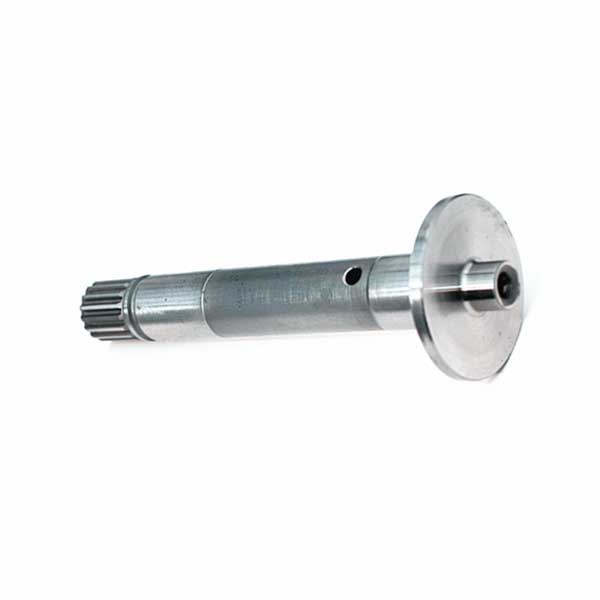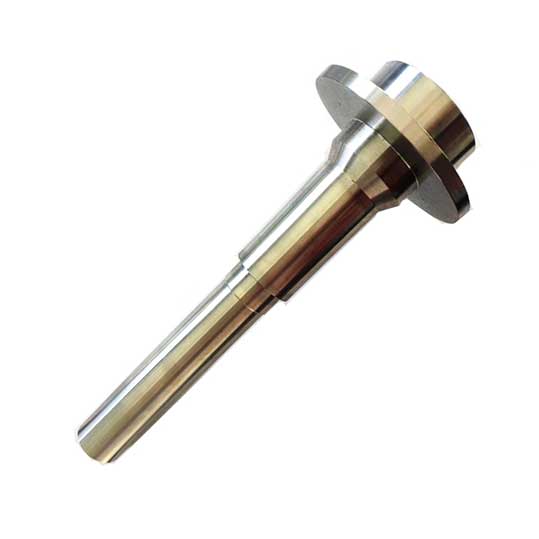Shaft forgings should choose different materials and adopt different heat treatment specifications (such as quenching and tempering, normalizing, quenching, etc.) according to different working conditions and use requirements, in order to obtain certain strength, toughness and wear resistance.
45 steel is a commonly used material for shaft forgings. It is cheap and can obtain better cutting performance after quenching and tempering (or normalizing), and can obtain comprehensive mechanical properties such as higher strength and toughness. The surface hardness after quenching can be improved. Up to 45~52HRC.
Alloy structural steel such as 40Cr is suitable for shaft forgings with medium precision and high rotational speed. This kind of steel has good comprehensive mechanical properties after quenching and tempering.
Bearing steel GCr15 and spring steel 65Mn, after quenching and tempering and surface high-frequency quenching. The surface hardness can reach 50~58HRC and has high fatigue resistance and good wear resistance, and can manufacture high-precision shafts.

38CrMoAIA nitrided steel can be used for the main shaft of precision machine tools (such as the grinding wheel shaft of grinding machine and the main shaft of coordinate boring machine). After quenching and tempering and surface nitriding, this kind of steel can not only obtain high surface hardness, but also maintain a soft core, so it has good impact resistance and toughness. Compared with carburizing and quenching steel, it has the characteristics of small heat treatment deformation and higher hardness.
Shaft forgings are one of the typical forgings often encountered in machines. It is mainly used to support transmission parts, transmit torque and bear load. Shaft forgings are rotating body forgings whose length is greater than the diameter and are generally composed of outer cylindrical surfaces, conical surfaces, inner holes, threads and corresponding end surfaces of concentric shafts. According to different structural shapes, shaft forgings can be divided into optical shafts, stepped shafts, hollow shafts and crankshafts. A shaft with an aspect ratio of less than 5 is called a short shaft, and one with an aspect ratio greater than 20 is called a slender shaft, and most shafts are in between.
The shaft is supported by bearings, and the shaft section that fits with the bearing is called the journal. The journal is the assembly benchmark of the shaft. Their accuracy and surface quality are generally required to be high. The technical requirements are generally formulated according to the main function and working conditions of the shaft. Usually, there are the following items:
Geometric shape accuracy: The geometric shape accuracy of shaft forgings mainly refers to the roundness and cylindricity of the journal, outer tapered surface, Morse taper hole, etc., and its tolerance should generally be limited within the dimensional tolerance range. For inner and outer circular surfaces with high precision requirements, the allowable deviation should be marked on the drawing.

Dimensional accuracy: In order to determine the position of the shaft, the journal that acts as a support usually requires high dimensional accuracy (IT5~IT7). The dimensional accuracy of the journal of the assembled transmission parts is generally lower (IT6~IT9).
Mutual position accuracy: The position accuracy requirements of shaft forgings are mainly determined by the position and function of the shaft in the machine. Generally, the coaxiality requirements of the shaft journal for assembling the transmission part to the supporting shaft journal should be guaranteed, otherwise the transmission accuracy of the transmission part (gear, etc.) will be affected and noise will be generated. For ordinary precision shafts, the radial runout of the matching shaft section to the supporting journal is generally 0.01~0.03mm, and for high-precision shafts (such as spindles), it is usually 0.001~0.005mm.
Shaft forgings can be in the form of bars, forgings and other rough forms according to the use requirements, production type, equipment conditions and structure. For shafts with little difference in outer diameter, bar is generally the main material; for stepped shafts or important shafts with large difference in outer diameter, forgings are often used, which not only saves materials but also reduces the workload of machining. Improve mechanical properties.
According to the different production scales, there are two forging methods for blanks: free forging and die forging. Free forging is mostly used in small and medium batch production, and die forging is used in mass production.


